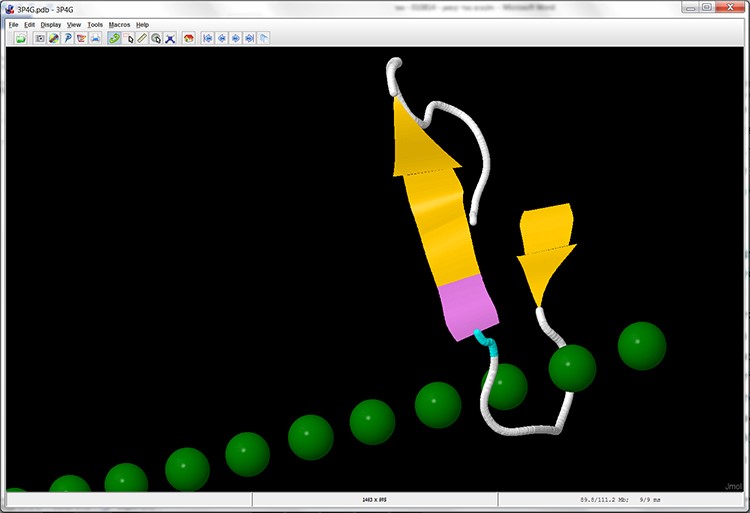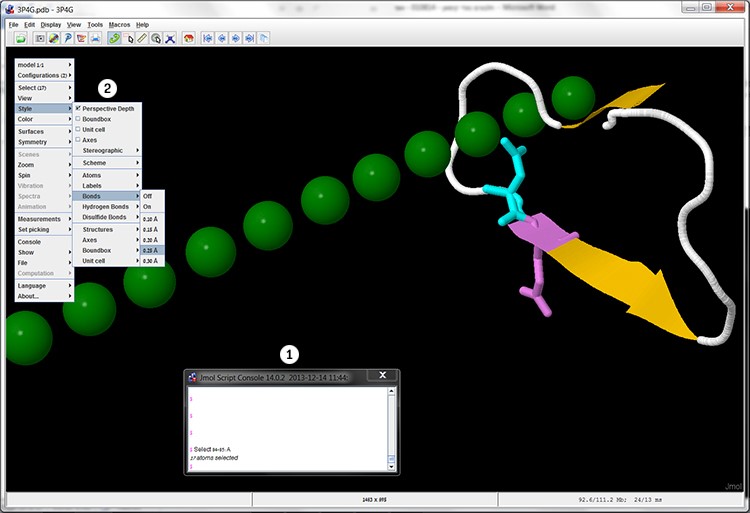The amino acids binding calcium ions
Now we will try to mark the amino acids in the model, that according to their biochemical traits (meaning hydrophilic), are believed to be involved in binding to the calcium ions and in this way contribute to antifreeze activity. Naturally we will focus on the amino acid Aspartate (marked D, also called Aspartic acid) at position 84, which has a negative charge. We will also display the amino acid adjacent to it, Glutamine (marked Q) at position 85, which is polar without charge.
We will perform the following:
- To select the amino acid Aspartate at position 84 in subunit A, open the console by right clicking the mouse and choosing console in the additional options menu; in the console window, right after the $ sign, type Select 84:A and press Enter.
- Color the selected amino acid in Cyan Color ➔ Atoms ➔ Cyan
- In a similar way, select the amino acid Glutamine at position 85 in subunit A and color it in violet.
15. The amino acid Aspartate at position 84 is part of this secondary structure:
Choose one answer:
- Alpha helix.
- Beta (pleated sheet) sheet.
- Loop.
- Is not part of any secondary structure.
The correct answer is: C. Loop, since the cyan marking appears on it.
16. The amino acid Glutamine at position 85 is part of this secondary structure:
Choose one answer:
- Alpha helix.
- Beta (pleated sheet) sheet.
- Loop.
- Is not part of any secondary structure.
The correct answer is: B. Beta (pleated sheet) sheet, since the marking in violet appears on it (screen 14).

Screen 14: Cartoon display of one ring-like unit in subunit A of the protein MpAFP. In this display the calcium ions are marked in green, the amino acid Aspartate at position 84 is marked in cyan and the amino acid Glutamine at position 85 is marked in violet.
In order to distinguish if one of these two amino acids binds the calcium ions, we will display their side chains using the Bonds display. We will perform the following:
- In order to select the amino acids at positions 84-85 in subunit A, open the console by right clicking the mouse and selecting Console in the additional options menu. In the console window, right after the $ sign, type Select 84-85:A and press Enter.
- To display the bonds they create Style ➔ Bonds ➔ 0.30Å this command displays the width of the chemical bonds spaced at 0.3Å. Å (Ångström) is a unit of length equal to 10-10 meter, which is equal to one-hundredth of a millionth of a centimeter. This does not mean that the size of the atoms or the bonds in the molecule have changed, only their display, and in this way we can see the chemical bonds.
17. Which of these amino acids binds the calcium ions?
Choose one answer:
- Both – the amino acid Aspartate (position 84) and the amino acid Glutamine (position 85).
- The amino acid Aspartate.
- The amino acid Glutamine.
- These amino acids do not bind the calcium ion, but other amino acids do.
The correct answer is: B. You can see (screen 15) that the side chain of the amino acid Aspartate is directed towards the calcium ion. However, the side chain of Glutamine is not directed towards the calcium ion. This indicates that Aspartate is apparently the one which binds the calcium ions.

Screen 15: Cartoon display of one ring-like unit in subunit A of the protein MpAFP. In this display the calcium ions are marked in green, the amino acid Aspartate at position 84 is marked in cyan and the amino acid Glutamine at position 85 is marked in violet. The Aspartate and Glutamine are selected (1), and their side chains are displayed (2).
In addition to the amino acid Aspartate at position 84, the amino acid Glycine (marked G) at positions 80 and 82 (and also other acids in the sequence motif) is also significant in binding the calcium ion to the protein, so its presence in this location would contribute to stabilizing the protein structure. This is true for any one of the 13 units with a ring-like structure in subunit A and in the other subunits as well. Stabilizing the protein structure with calcium ions enables the creation of a type of surface, which water molecules bind to through hydrogen bonds and form an ice-like plane, in which water molecules are spread one next to the other. In this way the solidification of water molecules into large ice nuclei is prevented. And so, the protein prevents the formation of ice, which can lead to the damage and destruction of cell membranes.